This summer eighteen bright, ambitious, and talented college students from across the country were selected to come to Scripps Institution of Oceanography at University of California San Diego to be a part of the Scripps Undergraduate Research Fellowship (SURF program). SURF is a ten-week fellowship program where select undergraduates have the opportunity to conduct innovative research alongside a scientist mentor while gaining important insight into graduate school and future careers in science.
View photos from the 2018 SURF Symposium here.
Learn about the 2018 SURF participants and the exciting research they conducted this summer:

Dante Capone is a senior at UC Santa Cruz majoring in earth science and marine biology. This summer he worked with Oliver Ashford in Lisa Levin’s lab on the relationship between ecosystem functioning and the gradient of geochemical activity in Costa Rican methane seeps. Capone’s research will be used in the larger study of biodiversity-ecosystem functioning relationships to determine how future anthropogenic reductions to the biodiversity of the seep communities may impact these systems. In the laboratory, he determined the biomass and calcification of macrofauna taken from methane seep sediments. Outside of the lab, Capone enjoyed swimming, surfing, intellectual talks with other SURFers, enjoying vegan food with his roommate Jack, and exploring the greater San Diego area through running. Upon returning to Santa Cruz, he plans to found a deep-sea science club and inspire his running teammates and peers to convert to a career in marine science. After graduating, Capone hopes to pursue a PhD in marine science, with the desire to incorporate cephalopods into his research.
Joanne Chung is transferring into the chemical engineering major at University of Michigan this fall. She first became interested in oceanography four years ago in a high school summer program offered at UC San Diego, where she did a fun project on measuring the particulate exposure around UC San Diego’s campus and built a particle counter. In the SURF program this summer, Chung continued her interest in particles by conducting research in Lynn Russell’s aerosol lab. Her summer research project focused on identifying the composition of seabird guano and deciphering air sample aerosol measurements to determine samples that contain seabird material. This research is important since guano-turned particles can grow into cloud droplets that impact climate through their ability to reflect solar radiation, thus having a cooling effect. Outside of the lab, Chung enjoyed learning how to surf for the first time and going on adventures with other SURF students. After graduating from college, she plans to work in industry and incorporate her research experiences into her work.
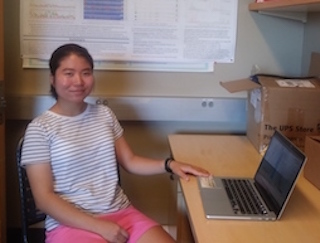
Monica Cisneros is currently attending Grossmont College and expects to transfer to a four-year university next year. This summer, she worked in Paul Jensen’s lab studying the ecology of marine bacteria. Cisneros’s project was to analyze the relationships between sediment characteristics, bacterial communities, and secondary metabolites with the goal of understanding the ecology of whole bacteria communities. This research is important to the field of marine resources and can be essential in new medicinal discoveries. She plans to obtain a bachelor’s degree in biochemistry with the ultimate goal of pursuing a career in the medical field.

Mary Cozy is a senior at UC Berkeley where she is pursuing a bachelor's degree in conservation and resource studies and a minor in education. Through her grade school experiences with the non-profit organization Ocean Discovery Institute, she developed a passion for marine science and conservation. During Cozy’s time at SURF, she worked in the Semmens lab testing the facial recognition software, i3s, on the Nassau Grouper (Epinephelus striatus). She also worked with the California Collaborative Fisheries Research Program (CCFRP), under the leadership of PhD student Erica Mason, assessing population densities in Marine Protected Areas in South La Jolla and Encinitas. Cozy plans on taking some time off after completing her undergraduate degree before continuing her education by pursuing a masters degree in conservation biology and/or education.
Alexis Cugini is a senior at UC San Diego where she is an ecology, behavior and evolution major and a marine sciences minor. Born and raised in Southern California, she has always had an interest in the environment and aspiration to become a biologist. This summer, Cugini worked with Simone Baumann-Pickering and graduate student Jenny Trickey on analyzing acoustic data taken off the Santa Barbara coast. Using the Matlab software Triton, she identified the call types of odontocetes (toothed whales) on spectrograms to determine what species are in the area and when. SURF gave Cugini a better understanding of the opportunities she could pursue post graduation, as well as what to expect from a research career. She plans to continue her education with a graduate degree, and possibly pursue a PhD as well.
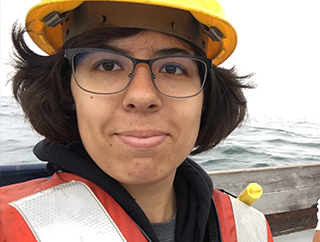
Carissa DeRanek is a senior at Harvey Mudd College where she majors in mathematical and computational biology. This summer, she worked with Sarah Purkey and Lynne Talley in studying the biogeochemistry of Drake Passage in the Southern Ocean. This research is important because the Southern Ocean is an important component of global ocean flow and acts as a major carbon sink. DeRanek hopes to use the skills she gained during SURF to study computational ecology in graduate school.
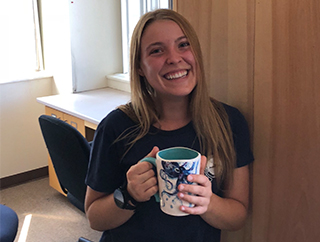
Milagros Esmerode is a junior at San Diego State University where she is majoring in cellular and molecular biology and minoring in Spanish. Her passion for biology and interest in research led her to apply for the SURF program, where she worked with Deirdre Lyons on evolutionary/developmental biology research. Esmerode’s research this summer utilized staining protocols and modern imaging techniques to help describe larval shell formation of slipper snails (Crepidula fornicata). The investigation will add important details on some of the lesser understood aspects of shell formation during the larval stage. She enjoyed her time at the Lyons Lab and hopes to return next summer in some context to continue her work.
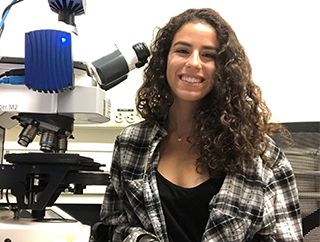
Shailja Gangrade is a senior at the University of Delaware where she studies marine science and environmental engineering. This summer, she worked in Lisa Levin’s lab under the mentorship of graduate students Lilly McCormick and Jessica Carriere-Garwood. Gangrade’s project focused on understanding visual luminoxyscapes (where specific combinations of light and oxygen exist) of larval organisms in the nearshore Southern California Bight. Through her research she learned to organize, manipulate, and analyze large data sets sourced from the California Cooperative Oceanic Fisheries Investigations (CalCOFI). Gangrade plans to use this experience to pursue a graduate program in oceanography and further her research in biophysical interactions and oceanic oxygen variability.
Jack Hawley is a senior majoring in oceanography at Humboldt State University. He is interested in geology and paleoceanography of the oceans, but on his free time also enjoys exploring the redwoods around his home campus as well as writing poetry. This summer Hawley conducted research in Lisa Tauxe’s lab, where he worked closely with postdoc Shuhui Cai to measure the past magnetic intensity on ceramics from Thailand over three different time periods (200 BCE-100 CE, 400-600 CE, and 14th-17th century). He plans to apply for graduate school to conduct research in geological oceanography, while continuing to write poetry that is inspired by his scientific work.
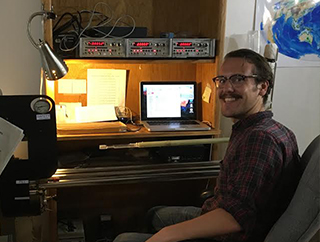
Hassan Mason studies mathematics and physics at the University of North Carolina - Wilmington. This summer, Hassan worked with physical oceanographers Julie McClean, Sara Gille, and graduate student André Palóczy on a project to analyze model data output from the Los Alamos Parallel Ocean Program II model. The goal of this project was to identify Antarctic Bottom Water production within the model and explore its relationships with advective heat transport around the Antarctic continental shelf. This research adds important information to the discussion of the stability of Antarctic ice shelves and potential future melting rates given climate change. In the future, Hassan plans on studying physical oceanography or theoretical fluid dynamics in graduate school.
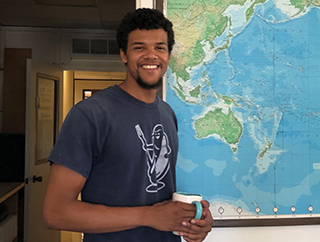
Sarina Mazzone is a senior at San Diego State University where she is pursuing a major in environmental science with a minor in geology. In the SURF program this summer, Sarina worked with geoscientist Jane Willenbring in her Cosmogenic Isotope Laboratory. Mazzone’s research investigated how particle size effects adsorption of metals in soil particles. Her surface soil samples came from local mima mounds and her investigations focused on fallout radionuclides, especially cosmogenic 10Be, and on developing a technique to use 7Be-10Be ratios to better understand the effect of grain size on fallout radionuclide concentrations. The opportunities that Mazzone had at Scripps this summer, from surfing on her lunch break to working alongside her amazing mentor, are things that she said she will never forget. Mazzone plans to go to graduate school to get a MS or PhD and continue research in the geosciences.
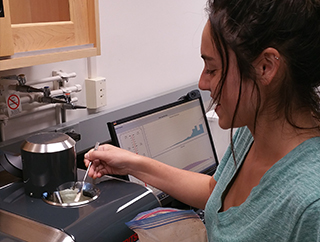
Joseph Molina is a senior at Coastal Carolina University with a major in marine science and a minor in statistics. His research interests include fisheries science, fish ecology, and trophic ecology. These interests fit well with Brice Semmens’ Lab, where Molina worked on a project examining the potential of using computer-aided photo-identification software for population studies on the critically endangered Nassau grouper. Along with researching the Nassau grouper, Joseph was also able to work in the field for the California Collaborative Fisheries Research Program (CCFRP). Using hook-and-line sampling, they surveyed Marine Protected Areas (MPAs) and non-MPAs (reference areas) by catching, measuring, tagging, and releasing fish. The goal of this program is to evaluate the effectiveness of MPAs along the California coast as conservation areas. Joseph’s experience in SURF helped confirm his interest in fisheries-related science and visualize a career focused in this direction.

Claire Mundi is a junior at Skidmore College with a double major in physics and geoscience. She is very interested in the natural applications of physics in the realm of climate science, specifically with respect to the polar regions. This summer, she worked with research physicist Dan Lubin, looking at phase characteristics of clouds over Greenland using micropulse lidar (MPL) data from the Greenland Summit. By analyzing the daily data sets, she looked at the frequency of radiatively active liquid water clouds occurring over the Greenland ice sheet. Mundi has greatly enjoyed the SURF program because it exposed her to research applications in cloud microphysics, an area of study that was completely new to her, and prepared her for attending graduate school in the future.
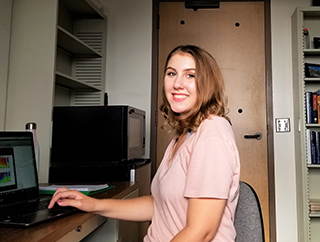
Katherine Riordan is a senior at West Chester University where she majors in marine biology with a minor in geology. At Scripps, she worked with Professor Jennifer Taylor in her crustacean biomechanics lab. Her work sought to identify morphological differences between two species of crabs that are known to climb in different orientations in their environments. She tested the crabs’ appendages by using two engineering-designed machines to measure crab leg hardness and stiffness and to compare relative strengths. Her favorite part of the SURF program was meeting all the other researchers and learning what they do at Scripps. Katherine is interested in marine mammals and hopes to study their biomechanics and diving physiology in the future. This fall, she will apply for graduate school here on the West Coast to get her masters and then her PhD.
Mariah Rojas is a senior at California State University, Dominguez Hills, majoring in biology with a concentration in cellular and molecular biology. This summer through the SURF program Mariah was able to explore her interests in ocean sciences by working in the research lab of Ryan Hechinger and under the mentorship of Dan Metz. Over the summer Mariah was able to explore the world of parasite ecology, which was quite the departure from the E. coli she studies back at her home institution. This summer also allowed Mariah to make large strides toward her goal of pursuing a PhD and becoming a research scientist.
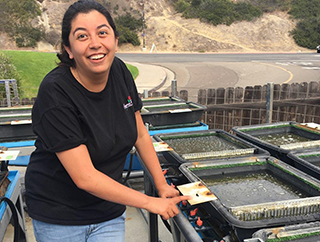
Nina Scott is a junior at the University of the Virgin Islands where she majors in Marine Biology. While at Scripps, Nina worked in Jennifer Taylor’s lab researching the mechanical properties of mantis shrimp telsons. Using engineering technologies, such as the nanoindenter and S.E.M. laser, Nina made measurements of hardness, stiffness and the overall composition of mantis shrimp. This information is an important tool in biomimicry, specifically with potential applications for creating bullet-safe materials. Scott said she fell in love with research and the collaborative relationship dynamics between the scientists. The SURF program influenced Nina to further her research experience at her home institution. After graduation, she hopes to continue her education by pursuing a PhD.
Christopher Souflis is a third-year student at Appalachian State University pursuing a bachelor's degree in biology with a concentration in environmental, evolutionary, and ecological biology, with minors in chemistry and sustainable development. Usually researching in the mountains, the SURF program allowed Souflis to explore ocean phenomena while also providing experience in scientific investigation and skills for genetic analysis. At Scripps, Souflis worked with marine microbiologist Brian Palenik on a project to characterize the microbial communities associated with seafoam, and seafoam formation. The SURF program has inspired Souflis to continue his career in scientific research, pursue a PhD, and spread the satisfaction of scientific inquiry.
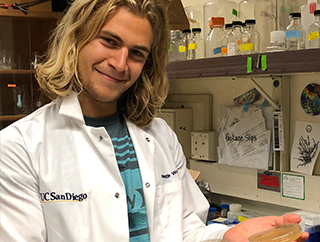
James Wilson is a junior at the University of Miami majoring in marine science, biology, and English with a concentration in creative writing. His research interests include population genomics, immunology of marine organisms, and the evolutionary progression of these processes. During the SURF program, James worked in the lab of Dimitri Deheyn to study the unique structures found on the common ice plant (Mesembryanthemum crystallinum). The purpose of these studies was to assess possible multi-functional adaptations for plants to thrive in coastal environments. James’s experience at Scripps has solidified his decision to attend graduate school and pursue marine science as a career.